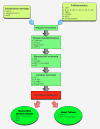Cardiac biomarkers in the intensive care unit
- PMID: 22397488
- PMCID: PMC3313856
- DOI: 10.1186/2110-5820-2-8
Cardiac biomarkers in the intensive care unit
Abstract
Cardiac biomarkers (CB) were first developed for assisting the diagnosis of cardiac events, especially acute myocardial infarction. The discoveries of other CB, the better understanding of cardiac disease process and the advancement in detection technology has pushed the applications of CB beyond the 'diagnosis' boundary. Not only the measurements of CB are more sensitive, the applications have now covered staging of cardiac disease, timing of cardiac events and prognostication. Further, CB have made their way to the intensive care setting where their uses are not just confined to cardiac related areas. With the better understanding of the CB properties, CB can now help detecting various acute processes such as pulmonary embolism, sepsis-related myocardial depression, acute heart failure, renal failure and acute lung injury. This article discusses the properties and the uses of common CB, with special reference to the intensive care setting. The potential utility of "multimarkers" approach and microRNA as the future CB are also briefly discussed.
Figures



Similar articles
-
Advances in congestive heart failure management in the intensive care unit: B-type natriuretic peptides in evaluation of acute heart failure.Crit Care Med. 2008 Jan;36(1 Suppl):S17-27. doi: 10.1097/01.CCM.0000296266.74913.85. Crit Care Med. 2008. PMID: 18158473 Review.
-
Cardiac troponins in the intensive care unit: common causes of increased levels and interpretation.Crit Care Med. 2007 Feb;35(2):584-8. doi: 10.1097/01.CCM.0000254349.10953.BE. Crit Care Med. 2007. PMID: 17205004 Review.
-
Elevation Mechanisms and Diagnostic Consideration of Cardiac Troponins under Conditions Not Associated with Myocardial Infarction. Part 1.Life (Basel). 2021 Sep 2;11(9):914. doi: 10.3390/life11090914. Life (Basel). 2021. PMID: 34575063 Free PMC article. Review.
-
Whole blood assessment of neutrophil gelatinase-associated lipocalin versus pediatricRIFLE for acute kidney injury diagnosis and prognosis after pediatric cardiac surgery: cross-sectional study*.Pediatr Crit Care Med. 2012 Nov;13(6):667-70. doi: 10.1097/PCC.0b013e3182601167. Pediatr Crit Care Med. 2012. PMID: 22895007 Clinical Trial.
-
Myocardial ischemia, cardiac troponin, and long-term survival of high-cardiac risk critically ill intensive care unit patients.Crit Care Med. 2005 Jun;33(6):1281-7. doi: 10.1097/01.ccm.0000166607.22550.87. Crit Care Med. 2005. PMID: 15942345
Cited by
-
Role of Cardiac Biomarkers in Cancer Patients.Cancers (Basel). 2021 Oct 29;13(21):5426. doi: 10.3390/cancers13215426. Cancers (Basel). 2021. PMID: 34771589 Free PMC article. Review.
-
Adrenomedullin and endothelin-1 are associated with myocardial injury and death in septic shock patients.Crit Care. 2016 Jun 9;20(1):178. doi: 10.1186/s13054-016-1361-y. Crit Care. 2016. PMID: 27282767 Free PMC article.
-
Perspectives on the value of biomarkers in acute cardiac care and implications for strategic management.Biomark Insights. 2013 Sep 3;8:115-26. doi: 10.4137/BMI.S12703. eCollection 2013. Biomark Insights. 2013. PMID: 24046510 Free PMC article.
References
-
- Blankesteijn W, Cremmers E, Lutgens E, Cleutjens J, Daemen M, Smits J. Dynamics of cardiac wound healing following myocardial infarction: observations in genetically altered mice. Acta Physiol Scand. 2001;173:75–82. - PubMed
-
- Liao Y-H, Cheng X. Autoimmunity in myocardial infarction. Int J Cardiol. 2006;112:21–26. - PubMed
-
- Caforio A. Ciculating cardiac autoantibodies in dilated cardiomyopathy and myocarditis: pathogenetic and clinical significance. Eur J Heart Failure. 2002;4(4):411–417. - PubMed
-
- Cooper L. The heat is off: immunosuprression for myocarditis revisited. Eur Heart J. 2009;30:1936–1939. - PubMed
-
- Packard R, Libby P. Inflammation in atherosclerosis: from vascular biology to biomarker discover and risk prediction. Clin Chem. 2008;54:24–38. - PubMed
LinkOut - more resources
Full Text Sources
Other Literature Sources

